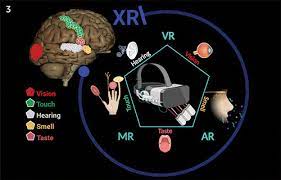How Virtual Reality is Revolutionizing PTSD Treatment
Post-Traumatic Stress Disorder (PTSD) is a severe mental health condition that can develop after experiencing or witnessing a traumatic event. It can manifest in a range of symptoms, including flashbacks, anxiety, and depression, which can significantly impact an individual’s quality of life. Traditional forms of therapy, such as talk therapy and medication, can be effective, but new advancements in technology have brought forward an innovative approach to treating PTSD: Virtual Reality (VR) therapy.
Virtual Reality therapy involves creating a simulated environment to treat a range of mental health conditions. The technology uses 3D graphics, computer-generated imagery, and headsets to immerse the individual into a simulated environment. The experience is designed to replicate the real world and trigger emotional and physical reactions similar to those experienced in real life.
In recent years, VR therapy has become an effective tool for treating PTSD. Studies have shown that exposure therapy, which is a form of VR therapy, can be particularly effective. Exposure therapy involves exposing the individual to stimuli that trigger their trauma in a controlled and safe environment. The aim is to desensitize the individual to their trauma by gradually exposing them to the stimuli until it no longer has an adverse effect.
The use of VR in exposure therapy allows individuals to confront and overcome their traumatic experiences without putting themselves in harm’s way. It is particularly useful for individuals who cannot access real-life exposure therapy due to physical or psychological limitations. VR therapy can also be customized to meet the individual’s needs, allowing for a more personalized approach to treatment.
Virtual Reality and Therapy Advancements
One of the most significant advantages of VR therapy is its ability to create a safe and controlled environment. In a virtual world, therapists can control the stimuli that trigger the individual’s PTSD symptoms, allowing them to gradually expose the individual to the stimuli at a pace that suits them. Therapists can also adjust the level of intensity of the stimuli, making it easier or more challenging for the individual to confront their trauma.
Another advantage of VR therapy is its versatility. It can be used to treat a range of PTSD symptoms, including flashbacks, anxiety, and nightmares. VR therapy can also be used to treat other mental health conditions such as phobias, depression, and addiction.
The effectiveness of VR therapy in treating PTSD has been supported by several studies. A study published in the Journal of Clinical Psychology found that VR exposure therapy was as effective as real-life exposure therapy in treating PTSD symptoms. The study also found that individuals who received VR therapy reported feeling less anxious and more confident in their ability to handle stressful situations.

Another study published in the British Journal of Psychiatry found that VR therapy was more effective than traditional forms of therapy in treating combat-related PTSD. The study involved military veterans who received either VR therapy or traditional therapy. The individuals who received VR therapy reported significantly greater improvement in their PTSD symptoms than those who received traditional therapy.
VR therapy is not without its limitations. One of the most significant challenges is its cost. VR technology can be expensive, and not all therapists have access to it. Additionally, not all individuals may feel comfortable using VR technology, and some may experience motion sickness or other adverse reactions.
Despite these challenges, the use of VR therapy in treating PTSD is a significant step forward in mental health treatment. Its ability to create a safe and controlled environment and its versatility make it a valuable tool in helping individuals overcome their trauma. As the technology becomes more accessible and affordable, it is likely that more individuals will be able to benefit from this innovative approach to mental health treatment.
Conclusion
VR therapy is a promising new advancement in the treatment of PTSD. It offers a safe and controlled environment for individuals to confront and overcome their trauma, and its versatility allows for a personalized approach to treatment. As more research is conducted and the technology becomes more accessible, VR therapy is likely to become a widely accepted form of mental health treatment for PTSD and other conditions.
However, it is essential to note that VR therapy should not be viewed as a replacement for traditional therapy or medication. It is most effective when used in combination with other forms of treatment. VR therapy should also only be conducted under the guidance of a trained therapist who specializes in the use of this technology.
Moreover, it is crucial to recognize that VR therapy is not suitable for everyone. Some individuals may not be ready to confront their trauma in a virtual environment, and others may not feel comfortable using the technology. As with any form of mental health treatment, the individual’s preferences and needs should be taken into account when considering VR therapy.
The use of virtual reality therapy in treating PTSD is a significant advancement in mental health treatment. It offers a safe and controlled environment for individuals to confront their trauma and overcome their symptoms. With more research and development, VR therapy is likely to become an increasingly accessible and effective form of mental health treatment. However, it is important to remember that it should be used in conjunction with other forms of treatment and only under the guidance of a trained therapist. Virtual reality therapy is a powerful tool that has the potential to change the way we approach mental health treatment and improve the lives of those living with PTSD.

One of the most promising applications of VR therapy in treating PTSD is for military veterans. According to the US Department of Veterans Affairs, approximately 11-20% of veterans who served in Operation Enduring Freedom and Operation Iraqi Freedom suffer from PTSD. These individuals often experience symptoms such as flashbacks, nightmares, and hyperarousal, which can significantly impact their daily lives.
VR therapy has shown particular promise in treating combat-related PTSD in veterans. A study published in the Journal of Traumatic Stress found that veterans who received VR therapy reported a significant reduction in their PTSD symptoms compared to those who received traditional therapy. The study also found that the benefits of VR therapy were sustained over time, indicating that it may offer a more long-lasting treatment solution for combat-related PTSD.
In addition to treating PTSD, VR therapy has also been used to help veterans with physical disabilities. The technology can be used to simulate physical activities and provide a form of rehabilitation for individuals with injuries such as amputations or spinal cord injuries. VR therapy can also be used to provide training for individuals with mobility impairments, allowing them to practice real-life skills in a virtual environment.
Another area where VR therapy has shown promise is in treating first responders who have experienced trauma. Police officers, firefighters, and paramedics are frequently exposed to traumatic events, which can lead to PTSD and other mental health conditions. VR therapy offers a safe and controlled environment for these individuals to confront their trauma and overcome their symptoms.















